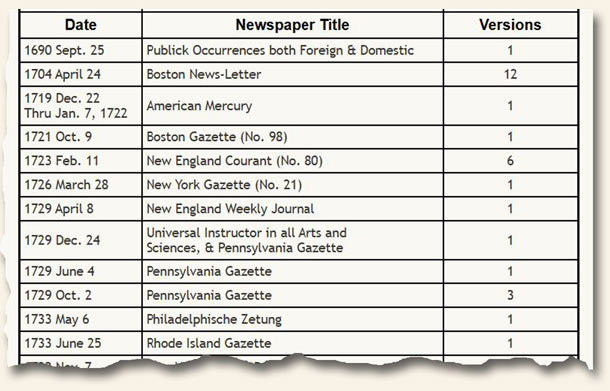Collecting Newspapers – The Basics (Part II) – What to Expect…
March 24, 2025 by GuyHeilenman · Leave a Comment
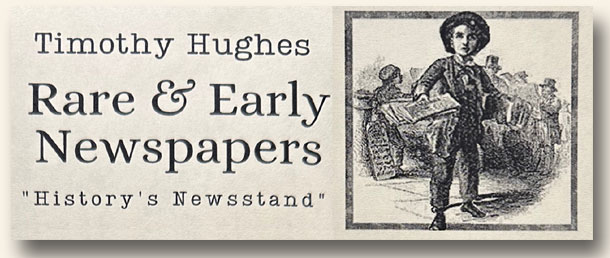
The 2nd installment of “Collecting Newspapers – The Basics” continues with a focus on the answers to handful of common questions: “Why does my newspaper look like it came from a bound volume, and what are the small holes along the spine?”, “Considering their age, what their condition?”, “Why is my issue so small?”, “How many pages do they have?, “Will it be brittle?” “What is ‘foxing’?”, “What does ‘chipping’ mean?, “Why is the old newspaper I just received so white – is it a reprint?”, and similar. Whereas many of these questions are answered in detail through dedicate posts, a quick primer is provided the page shown below which comes from the brochure we send out to new collectors.
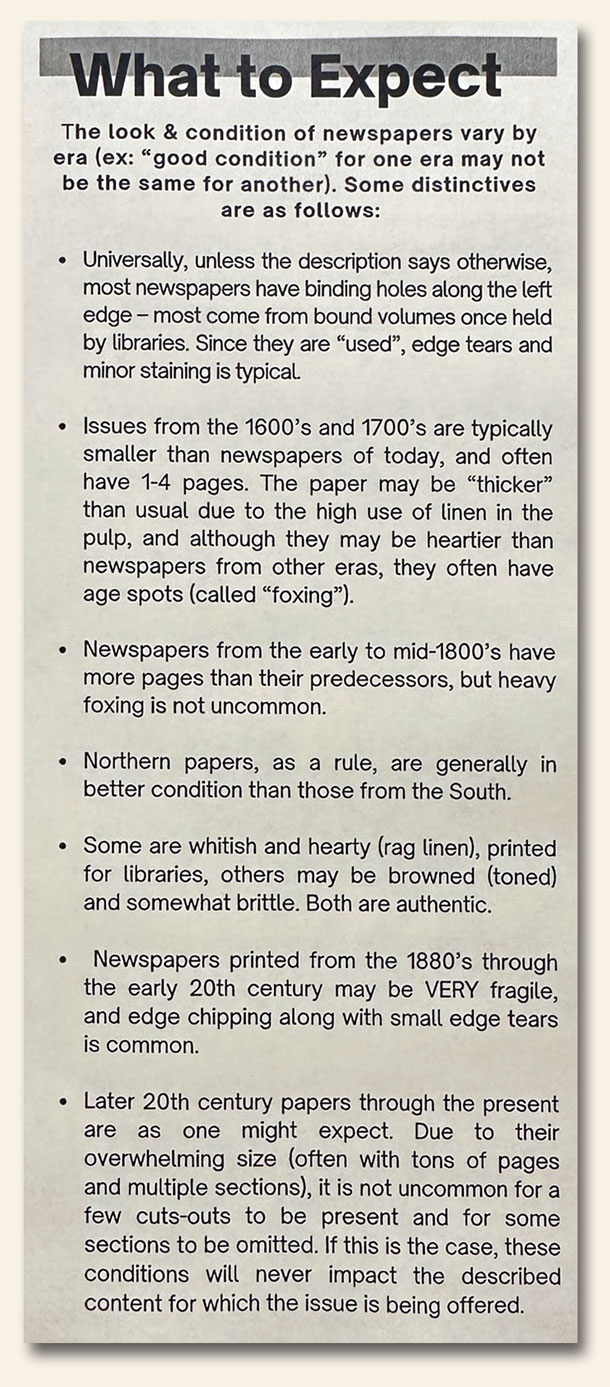
Additional information about the hobby can be found through this Blog and on the Rare Newspapers’ website.
Collecting Newspapers – The Basics (Part I) – Eras, Topics, and Titles…
February 24, 2025 by GuyHeilenman · Leave a Comment
We, (Timothy Hughes Rare & Early Newspapers), have been offering old and historic newspapers to the collecting community since 1976, with Tim’s first acquisition for his own personal collection taking place in 1975. For those who are either unfamiliar with or new to this amazing hobby, today we are kicking off a revisit of a series of posts, “Collecting Newspapers – The Basics”, to serve en masse as a Primer for those interested in learning more about the collectible. The first installment (below) may appear to be a bit self-serving, but the heart behind it is simply to let seekers know the span of topics and types of newspapers which can be found.

So, what can be found on the pages of Rare & Early Newspapers? While the possibilities are nearly endless, a sampling includes:
Eras: Colonial, Early 1800’s Americana, Reconstruction, Industrial Revolution, Old West, Victorian, Roaring 20’s, “The 60’s”, and similar, plus an abundance of war-eras (French and Indian War, Revolutionary War, War of 1812, Texas-Mexican War, Civil War, Spanish-American War, WWI, WWII, Korean War, Vietnam War, etc.). Some prefer to collect by centuries (1600’s, 1700’s, 1800’s, 1900’s, and now, even the 2000’s).
Topics: Black Americana, Mormon, Gangsters & Outlaws, Judaica, Sports & Entertainment, Inventors & Inventions, Gunfights, Deaths of the Famous, Politics, Presidents, Proclamations, Amendments, Historic SCOTUS Decisions, Trials & Tragedies, Slavery, Famous 1sts & Records, Movie Premiers, Famous Illustrators, and more.
Titles: Oxford/London Gazette, Harper’s Weekly, Frank Leslie’s, Scientific American, Gentleman’s Magazine, London Gazette, Village Voice, Sporting News, and nearly 1,000 other newspaper titles from throughout the United States, along with dozens specifically from the Old West and Colonial eras. Rare & unusual titles are also desirable.
People: Pick any famous person from the 1600’s through 20th century, regardless of the genre or genres for which they are known, newspapers will have undoubtedly recorded what brought their name into public awareness.
Historical Events: Without making a feeble attempt to list examples, if an event has an historical bent, not only will newspapers have recorded it, but they will have done so within the context of the period in which it happened. This is one of the reasons why many writers of both non-fiction and historical fiction seek newspapers from the time and (if possible) location of when and where an event took place. Newspapers make wonderful source material.
These and additional collecting themes can be found on the homepage of RareNewspapers.com. Also take note of the “View All Categories” tab on the right side towards the bottom of the page. If you don’t see what you are looking for, let us know. Our effort to add links to the collecting interests of those who appreciate old newspapers is ongoing.
Additional collecting themes/ideas can also be found throughout this Blog.
“Collecting Newspapers – The Basics” (Part V) – Reprints…
April 5, 2024 by GuyHeilenman · Leave a Comment
While “fakes” in collectibles, depending upon the item being sought (stamps, coins, Hummels, etc.), can be common, thankfully such is not the case with Rare and Early Newspapers. Furthermore, the common “fakes” (called “reprints”) are well documented and were rarely done with nefarious motives. Part of the reason for the rarity of reprints is likely the price-point of most collectible newspapers (still quite low) in comparison to the cost of creating a fake which would be good enough to pass as authentic to someone who is familiar with the collectible. Printing methods, ink, paper, era-specific (“tell-tale”) environmental impact, and more have varied so significantly over time, the cost and effort it would take to create profitable forgeries cost/effort prohibitive. Still, there are exceptions – and being “in the know” can save one from being duped out of their hard-earned savings.
The issue-specific attributes which help to distinguish a reprint from an authentic issue would fill a book to rival Tolstoy’s War and Peace – making an attempt to do so within a single post absurd. However, over the past decade we have created over a dozen posts in an effort to cover as much as possible – specifically targeting the most common. Hopefully you will find them helpful:
POSTS REGARDING COMMON REPRINTS
“Collecting Newspapers – The Basics” (Part III) – Newspaper Care…
December 11, 2023 by GuyHeilenman · Leave a Comment
We, (Timothy Hughes Rare & Early Newspapers), have been collecting and offering old and historic newspapers to the collecting community since 1976 (Tim’s first purchase was in 1975). For those who are either unfamiliar with or new to this amazing hobby, today we are kicking off a series of posts, “Collecting Newspapers – The Basics”, to serve en masse as a Primer for those interested in learning more about the collectible. This is the 3rd installment. Enjoy.

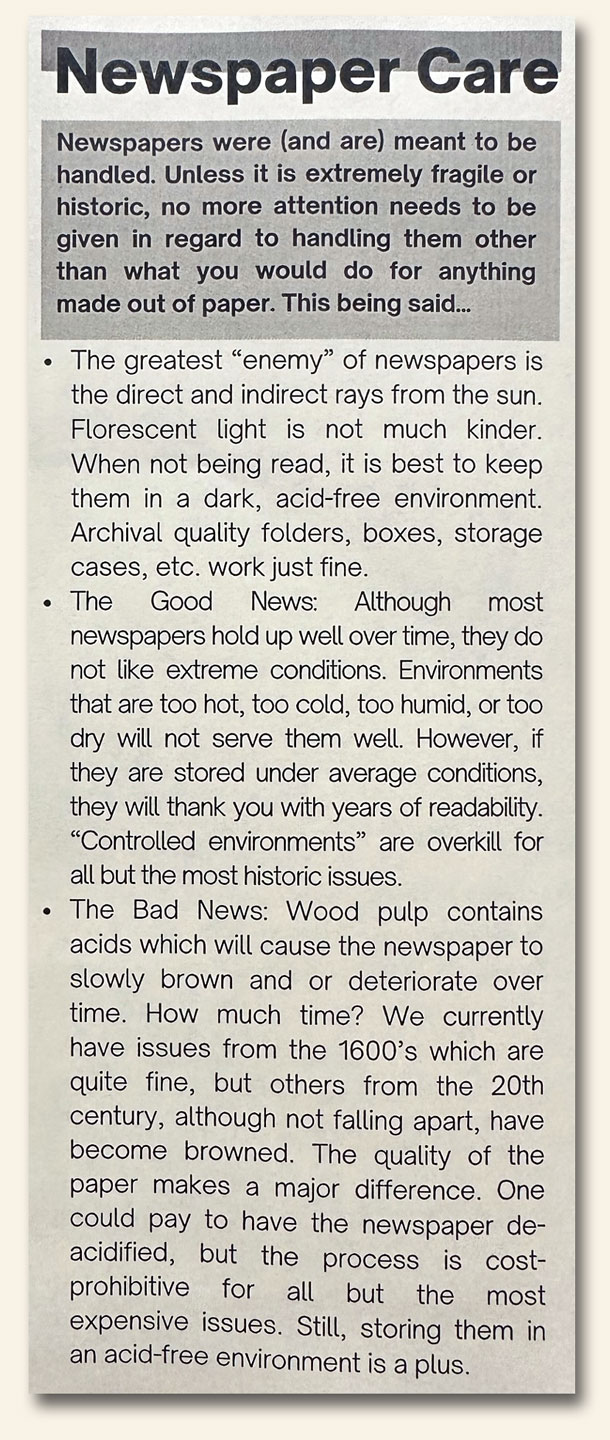
Additional information about the hobby can be found through this Blog and on the Rare Newspapers’ website.
From the Vault: Best of the 20th century?
April 10, 2023 by GuyHeilenman · Leave a Comment
As newspaper collectors we dream of “the event” we’d like to add to our collection. It’s the search for that issue–or issues–which make this a fascinating hobby. This is, after all, a very visual hobby. How displayable are stamps and coins? Huge headlines proclaiming a cataclysmic event or magnificent achievement lend themselves so well to display, much more so than an original document about the event.
The 20th century had a great wealth of interesting events. But what is the best? If you could only make one choice, what single headline of the 20th century would you most want to see in your collection?
I wrestle with how to approach this thought: most life-altering? most recognizable? most historic? most appealing for display? I believe the first Wright brothers‘ flight is the most life-altering; “Dewey Defeats” Truman” as the most recognizable; and a great “Titanic Sinks” report as the most displayable. Some newspapers did much with the events of the gangster era, and certainly the “careers” of Bonnie & Clyde, John Dillinger and Al Capone are well known and significant reports would be attention-grabbers on any wall. On a more positive note there are some spectacular “V-E Day” and “V-J Day” issues celebrating the end of World War II. But limiting myself to just a single issue I would take “Titanic Sinks”. ….what’s your thought?
Note: The History’s Newsstand Blog went live for the first time in 2008. Since then our goal has been to provide informative of interest to both novice and well-oiled collectors of Rare & Early Newspapers. The focus of the “From the Vault” series is to introduce the current generation of collectors to posts from the past (with occasional updates as appropriate). The original post shown above can be viewed at:
WNEP TV turns the spotlight on Rare & Early Newspapers…
January 13, 2023 by GuyHeilenman · Leave a Comment
A Northeastern Pennsylvania television station (WNEP) recently highlighted Tim Hughes and the Rare & Early Newspapers efforts to serve the world-wide collectible community. Although brief, any opportunity for Tim to share his love for the hobby is a bonus.
Millions of newspapers for sale in Lycoming County (PA)
Collecting Old/Historic Newspapers: The 1600s & 1700s…
March 24, 2022 by GuyHeilenman · Leave a Comment
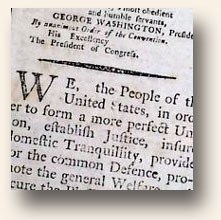 At Timothy Hughes Rare & Early Newspapers (rarenewspapers.com), we are often asked what types of “old Newspapers” are worth collecting. One of the beauties of the hobby is that the possibilities are endless. While we have our own preferences, once a month we will simply direct readers of the History’s Newsstand blog to an era, theme, topic, etc. for which our collector friends have expressed interest. This month’s focus is shown below. Feel free to email me at guy@rarenewspapers.com with your own collecting preference/s. Perhaps one day we’ll feature it/them as well.
At Timothy Hughes Rare & Early Newspapers (rarenewspapers.com), we are often asked what types of “old Newspapers” are worth collecting. One of the beauties of the hobby is that the possibilities are endless. While we have our own preferences, once a month we will simply direct readers of the History’s Newsstand blog to an era, theme, topic, etc. for which our collector friends have expressed interest. This month’s focus is shown below. Feel free to email me at guy@rarenewspapers.com with your own collecting preference/s. Perhaps one day we’ll feature it/them as well.
The 1600s and 1700s
Collecting Old/Historic Newspapers: The Revolutionary War…
March 17, 2022 by GuyHeilenman · Leave a Comment
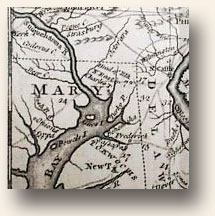 At Timothy Hughes Rare & Early Newspapers (rarenewspapers.com), we are often asked what types of “old Newspapers” are worth collecting. One of the beauties of the hobby is that the possibilities are endless. While we have our own preferences, once a month we will simply direct readers of the History’s Newsstand blog to an era, theme, topic, etc. for which our collector friends have expressed interest. This month’s focus is shown below. Feel free to email me at guy@rarenewspapers.com with your own collecting preference/s. Perhaps one day we’ll feature it/them as well.
At Timothy Hughes Rare & Early Newspapers (rarenewspapers.com), we are often asked what types of “old Newspapers” are worth collecting. One of the beauties of the hobby is that the possibilities are endless. While we have our own preferences, once a month we will simply direct readers of the History’s Newsstand blog to an era, theme, topic, etc. for which our collector friends have expressed interest. This month’s focus is shown below. Feel free to email me at guy@rarenewspapers.com with your own collecting preference/s. Perhaps one day we’ll feature it/them as well.
The Revolutionary War
Why collect Rare & Early Newspapers? July 23rd…
July 23, 2021 by GuyHeilenman · Leave a Comment
 It has often been said (by Tim Hughes and other collectors of historical newspapers) that “History is never more fascinating than when it’s read from the day it was first reported”. When past events are studied through the eyes of those who experienced them first-hand, revisionism, “woke”-ism, and the politicizing of history is kept to a minimum. The breadth and depth of our understanding of the past is undoubtedly enhanced when we view past events through the lens of contemporaneous reporting. This is one of the great satisfactions those of us at Rare & Early Newspapers enjoy on a daily basis, and the driving force behind why more and more people are joining the ranks of those who collect newspapers.
It has often been said (by Tim Hughes and other collectors of historical newspapers) that “History is never more fascinating than when it’s read from the day it was first reported”. When past events are studied through the eyes of those who experienced them first-hand, revisionism, “woke”-ism, and the politicizing of history is kept to a minimum. The breadth and depth of our understanding of the past is undoubtedly enhanced when we view past events through the lens of contemporaneous reporting. This is one of the great satisfactions those of us at Rare & Early Newspapers enjoy on a daily basis, and the driving force behind why more and more people are joining the ranks of those who collect newspapers.
While history certainly has its share of triumph and tragedy, success and failure, progress and regression, together they combine to form the tapestry of our shared human experience. Warts have been part of daily life since we made our all-to-quick exit from The Garden, but hopefully, as we study history in order to learn from the good and the bad, the knowledge we gain by observing the past will inform our actions of the present to help pave the way for a few less blemishes in the future. Our hope is that those who collect historic newspapers 100… 200… 500 years from now will find we were good stewards of our own current events.
It is with the above in mind we will occasionally post the list of newspapers we have for a specific day in history.
Today we explore: July 23rd
Exploring newspapers, 1900-1949… Any Discoveries?
November 14, 2014 by GuyHeilenman · 3 Comments
 A unique pleasure one often experiences from the collecting of Rare & Early Newspapers is the hidden nuggets found within nearly every issue. Whereas collectible newspapers are often purchased due to their historic headlines or perhaps their rarity, the undisclosed content – whether articles or ads – often provides intrigue and a historical perspective that go far beyond the original reason for seeking the issue.
A unique pleasure one often experiences from the collecting of Rare & Early Newspapers is the hidden nuggets found within nearly every issue. Whereas collectible newspapers are often purchased due to their historic headlines or perhaps their rarity, the undisclosed content – whether articles or ads – often provides intrigue and a historical perspective that go far beyond the original reason for seeking the issue.
With this in mind, let’s have some fun!
This post will serve as a home for collectors to brag about the non-headliner discoveries they’ve found within newspapers dated from 1900-1949. Share your finds. All we ask is for everyone to refrain from using this post as a means for offering collectible newspapers for sale. It’s intended to purely be a “no-agenda” platform for sharing one of the simple joys of collecting.
If you are new to the hobby (or already are a collector) and would like to join in the hunt, to help you get started we are offering a highly discounted set of 5 issues, one per decade, covering the 1st half of the 20th century. This offering may be viewed at: Five-Issue Set (1900-1949)








